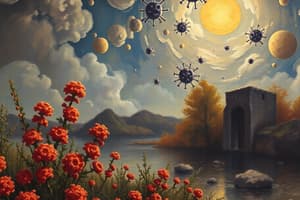Podcast
Questions and Answers
Microbiology is the study of organisms and agents too small to be seen by the ______ eye.
Microbiology is the study of organisms and agents too small to be seen by the ______ eye.
naked
One of the main goals at the end of the first chapter of this course is to learn how to ______ microbiology as a science.
One of the main goals at the end of the first chapter of this course is to learn how to ______ microbiology as a science.
define
Identifying the historical events and key figures associated with the birth of microbiology is crucial for understanding the science's ______.
Identifying the historical events and key figures associated with the birth of microbiology is crucial for understanding the science's ______.
development
Fields of study in microbiology can be divided broadly into basic microbiology and ______ microbiology. The key difference is basic microbiology focuses on fundamental research, while applied microbiology seeks to produce solutions for real world problems.
Fields of study in microbiology can be divided broadly into basic microbiology and ______ microbiology. The key difference is basic microbiology focuses on fundamental research, while applied microbiology seeks to produce solutions for real world problems.
Microbiology includes the study of a diverse group of biological agents, including bacteria, archaea, fungi, protazoa, algae, viruses, and even certain multicellular ______.
Microbiology includes the study of a diverse group of biological agents, including bacteria, archaea, fungi, protazoa, algae, viruses, and even certain multicellular ______.
Flashcards
Microbiology
Microbiology
The study of organisms and agents too small to be seen without a microscope.
Basic Microbiology
Basic Microbiology
The foundational area of microbiology studying microbes in isolation and their basic functions.
Applied Microbiology
Applied Microbiology
The use of microbial knowledge to develop practical applications in various fields.
Key Historical Figures in Microbiology
Key Historical Figures in Microbiology
Signup and view all the flashcards
Scope of Microbiology
Scope of Microbiology
Signup and view all the flashcards
Study Notes
Chapter 1: Introduction to Microbiology: Scope and Brief History
- Learning Outcomes:
- Define microbiology as a science
- List and describe examples of basic and applied microbiology fields.
- Describe key historical events and people associated with the birth of microbiology.
What is Microbiology?
- Study of organisms and agents too small to be seen by the naked eye (<1mm)
- Microbiology is the study of organisms that exist as single cells (or acellular) and contain a nucleic acid genome for at least part of their life cycle, and are capable of replicating that genome.
Microbiology Fields
- Basic Microbiology:
- Virology (viruses)
- Mycology (fungi)
- Phycology (algae)
- Protozoology (protozoa)
- Bacteriology (bacteria)
- Applied Microbiology:
- Industrial microbiology
- Agricultural microbiology
- Microbial ecology
- Medical microbiology
- Immunology
- Public health microbiology
- Food & Dairy microbiology
Historical Figures and Events
- Zacharias Janssen (1597): Invented the first compound microscope (3-10x).
- Athanasius Kircher: Suggested to be the first to observe microorganisms.
- Robert Hooke (1665): Used a simple compound microscope (30x) to observe "cells" in cork and "elongated stalks" (fungi).
- Antonie van Leeuwenhoek (1676): Observed "wee animalcules".
- Francesco Redi (1668): Performed an experiment on spontaneous generation, and disproved it for maggots.
- John Needham (1745): Conducted an experiment on spontaneous generation, but his results were later disproved.
- Lazzaro Spallanzani (1768): Perfomed an experiment on spontaneous generation, that showed air may be required for the vital force to work.
- Franz Schulze and Theodor Schwann: Passed air through strong acids and red-hot tubes, showing microbial growth was related to the air.
- Georg Friedrich Schröder and Theodor von Dusch (1850): Filtered air through sterile cotton wool, and showed no microbial growth.
- Louis Pasteur (1822-1895): Performed experiments with swan-neck flasks, solidifying the concept that life comes from life. "Father of Modern Microbiology".
- John Tyndall (1820-1893): Demonstrated that dust carries microorganisms and developed the process of "tyndallization."
- Girolamo Fracastoro (1478-1553): Suggested invisible living creatures cause diseases.
- Agostino Bassi (1773-1856): Showed that a disease of silkworms was caused by a fungus (demonstrated causal relationship between a microorganism and the disease)
- Miles Joseph Berkeley: Determined the fungus (Phytophthora infestans) that causes potato blight
- Heinrich Anton de Bary (1853): "Founding father of Plant Pathology" showed that smut and rust fungi caused crop diseases.
- Ignaz Philipp Semmelweis (1861): Introduced a policy of handwashing with chlorinated lime solutions and found mortality to drop from 18% to 2.4%.
- Joseph Lister (1867): Showed that microorganisms are the causal agents of disease; developed the process of sterilizing surgical instruments
- Louis Pasteur: Demonstrated that the pébrine disease of silkworms was caused by a protozoan
- Robert Koch (1843-1910): Established the relationship between Bacillus anthracis and anthrax, and developed Koch's postulates.
- Charles Chamberland (1851-1908): Developed porcelain bacterial filters
- Martinus Beijerinck: Considered one of the founders of virology. Discovered that tobacco mosaic disease is caused by an infectious agent "smaller than a bacterium", calling it a "virus".
- Paul Ehrlich: Developed 606th compound SALVARSAN (organic arsenical) to treat syphilis.
- Alexander Fleming: Discovered penicillin from Penicillium
Future of Microbiology
- Infectious diseases
- New and improved industrial process
- Renewable resources
- Microbial ecology and Microbial diversity
Studying That Suits You
Use AI to generate personalized quizzes and flashcards to suit your learning preferences.



